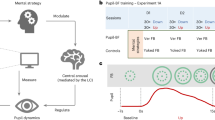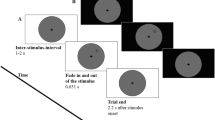Abstract
Pupil size is usually regarded as a passive information channel that provides insight into cognitive and affective states but defies any further control. However, in a recent study (Ehlers et al. 2015) we demonstrate that sympathetic activity indexed by pupil dynamics allows strategic interference by means of simple cognitive techniques. Utilizing positive/negative imaginings, subjects were able to expand pupil diameter beyond baseline variations; albeit with varying degrees of success and only over brief periods. The current study provides a comprehensive replication on the basis of considerable changes to the experimental set-up. Results show that stricter methodological conditions (controlled baseline settings and specified user instructions) strengthen the reported effect, whereas overall performance increases by one standard deviation. Effects are thereby not restricted to pupillary level. Parallel recordings of skin conductance changes prove a general enhancement of induced autonomic arousal. Considering the stability of the results across studies, we conclude that pupil size information exceeds affective monitoring and may constitute an active input channel in human–computer interaction. Furthermore, since variations in pupil diameter reliably display self-induced changes in sympathetic arousal, the relevance of this parameter is strongly indicated for future approaches in clinical biofeedback.




Similar content being viewed by others
References
Al-Omar, D., Al-Wabil, A., & Fawzi, M. (2013). Using pupil size variation during visual emotional stimulation in measuring affective states of non communicative individuals. In C. Stephanidis (Ed.), Universal access in human-computer interaction. User and context diversity (pp. 253–258). Berlin: Springer.
Ark, W., Dryer, D., & Lu, D. (1999). The emotion mouse. In H. J. Bullinger, & J. Ziegler (Eds.), Human-computer interaction: Ergonomics and user interfaces (pp. 818–823). Lawrence Erlbaum Assoc.
Bayer, M., Sommer, W., & Schacht, A. (2011). Emotional words impact the mind but not the body: Evidence from pupillary responses. Psychophysiology, 48, 1–9.
Beatty, J., & Kahneman, D. (1966). Pupillary changes in two memory tasks. Psychonomic Science, 5, 371–372.
Bradley, M. M., & Lang, P. J. (2000). Measuring emotion: Behavior, feeling and physiology. In R. D. Lane & L. Nadel (Eds.), Cognitive neuroscience of emotion (pp. 242–276). Oxford: Oxford University Press.
Bremner, F. D. (2012). Pupillometric evaluation of the dynamics of the pupillary response to a brief light stimulus in healthy subjects. Investigative Ophthalmology and Visual Science, 53, 7343–7347.
Dan-Glauser, E. S., & Scherer, K. R. (2011). The Geneva affective picture database (GAPED): A new 730-picture database focusing on valence and normative significance. Behavior Research Methods, 43(2), 468–477.
Ehlers, J., Bubalo, N., Loose, M., & Huckauf, A. (2015). Towards voluntary pupil control—training affective strategies? In Proceedings of the 2nd international conference on physiological computing systems (pp. 5–12). doi:10.5220/0005240000050012.
Ehlers, J., Georgi, J., & Huckauf, A. (2014). Improving voluntary pupil size changes for HCI. In Proceedings of the 8th international conference on pervasive computing technologies for healthcare (pp. 343–346). ACM.
Ekman, I., Poikola, A., Mäkäräinen, M., Takal, T., & Hämäläinen, P. (2008). Voluntary pupil size change as control in eyes only interaction. In Proceedings of the 2008 symposium on eye tracking research & applications. ETRA ‘08 (pp. 115–118). ACM.
Fredrickson, B. L., Mancuso, R. A., Branigan, C., & Tugade, M. M. (2000). The undoing effect of positive emotions. Motivation and Emotion, 24, 237–258.
Georgi, J., Kowalski, D., Ehlers, J., & Huckauf, A. (2015). Real-time feedback towards voluntary pupil control in human-computer interaction: Enabling continuous pupillary feedback. In H. M. Fardoun, V. M. R. Penichet, & D. M. Alghazzawi (Eds.), Communications in Computer and Information Science (Vol. 515). ICTs for improving patients rehabilitation research techniques (pp. 104–115). Berlin: Springer Verlag.
Healey, J., & Picard, R. W. (2005). Detecting stress during real-world driving tasks using physiological sensors. IEEE Transactions on Intelligent Transportation Systems, 6, 156–166.
Hess, E. H. (1972). Pupillometrics. In N. S. Greenfield & R. A. Sternbach (Eds.), Handbook of psychology (pp. 491–531). New York: N.S. Holt, Rinehart and Winston.
Jackson, I., & Sirois, S. (2009). Infant cognition: Going full factorial with pupil dilation. Developmental Science, 12, 670–679.
Jacob, R. J. K. (1996). The future of input devices. ACM Computing Surveys, 28, 177–179.
Janisse, M. P. (1974). Pupil size, affect and exposure frequency. Social Behavior and Personality, 2, 125–146.
Jennings, J. R., Kamarck, T., Stewart, C., Eddy, M., & Johnson, P. (1992). Alternate cardiovascular baseline assessment techniques: Vanilla or resting baseline. Psychophysiology, 29, 742–750.
Kahneman, D., & Beatty, J. (1966). Pupil diameter and load on memory. Science, 154, 1583–1585.
Lehrer, P. M., Vaschillo, E., & Vaschillo, B. (2000). Resonant frequency biofeedback training to increase cardiac variability: Rationale and manual for training. Applied Psychophysiology and Biofeedback, 25(3), 177–191.
Loewenfeld, I. E. (1966). Comment on Hess’ findings. Survey of Opthalmology, 11, 291–294.
Loewenstein, G., & Lerner, J. S. (2003). The role of affect in decision making. In R. Davidson, H. Goldsmith, & K. Scherer (Eds.), Handbook of affective science (pp. 619–642). Oxford: Oxford University Press.
Palinko, O., Kun, A. L., Shyrokov, A., & Heeman, P. (2010). In Proceedings of the 2010th symposium on eye-tracking research & applications (pp. 141–144).
Partala, T., & Surakka, V. (2003). Pupil size variation as an indication of affective processing. International Journal of Human-Computer Studies, 59, 185–198.
Raymond, J., Varney, C., Parkinson, L. A., & Gruzelier, J. H. (2005). The effects of alpha/theta neurofeedback on personality and mood. Cognitive Brain Research, 23(2), 287–292.
Sakakibara, M., Takeuchi, S., & Hayano, J. (1994). Effect of relaxation training on cardiac parasympathetic tone. Psychophysiology, 31, 223–228.
SensoMotoric Instruments. iView XTM Hi-Speed 1250. http://www.smivision.com/en/gaze-and-eye-tracking-systems/.
Sequeira, H., Hot, P., Silvert, L., & Delplanque, S. (2000). Electrical autonomic correlates of emotion. International Journal of Psychophysiology, 71, 50–56.
Sirois, S., & Jackson, I. (2014). Pupillometry. WIREs Cognitive Science, 5, 679–692.
Steinhauer, R., Siegle, G., Condray, R., & Pless, M. (2004). Sympathetic and parasympathetic innervation of pupillary dilation during sustained processing. International Journal of Psychophysiology, 52, 77–86.
Stoll, J., Chatelle, C., Carter, O., Koch, C., Laureys, S., & Einhäuser, W. (2013). Pupil responses allow communication in locked-in syndrome patients. Current Biology, 23, R647–R648.
Strauch, C., Georgi, J., Huckauf, A., & Ehlers, J. (2015). Slow trends: A problem in analysing pupil dynamics. In Proceedings of the 2nd international conference on physiological computing systems.
Vasudeva, S., Claggett, A. L., Tietjen, G. E., & McGrady, A. V. (2003). Biofeedback-assisted relaxation in migraine headache: Relationship to cerebral blood flow velocity in the middle cerebral artery. Headache: The Journal of Head and Face Pain, 43(3), 245–250.
Wilhelm, B., Giedke, H., Luèdtke, H., Bittner, E., Hofmann, A., & Wilhelm, H. (2001). Daytime variations in central nervous system activation measured by pupillographic sleepiness test. Journal of Sleep Research, 10, 1–7.
Winn, B., Whitaker, D., Elliott, D. B., & Phillips, N. J. (1994). Factors affecting light-adapted pupil size in normal human subjects. Investigative Ophthalmology and Visual Science, 35, 1132–1137.
Funding
This study was supported by the Collaborative Research Center (SFB Transregio 62) by the Deutsche Forschungsgemeinschaft (DFG).
Author information
Authors and Affiliations
Corresponding author
Ethics declarations
Conflict of interest
Authors declare that they have no conflict of interest.
Ethical Approval
All procedures performed in studies were in accordance with the ethical standards of the institutional research committee and with the 1964 Helsinki declaration and its later amendments or comparable ethical standards.
Informed Consent
Informed consent was obtained from all individual participants included in the study.
Rights and permissions
About this article
Cite this article
Ehlers, J., Strauch, C., Georgi, J. et al. Pupil Size Changes as an Active Information Channel for Biofeedback Applications. Appl Psychophysiol Biofeedback 41, 331–339 (2016). https://doi.org/10.1007/s10484-016-9335-z
Published:
Issue Date:
DOI: https://doi.org/10.1007/s10484-016-9335-z




